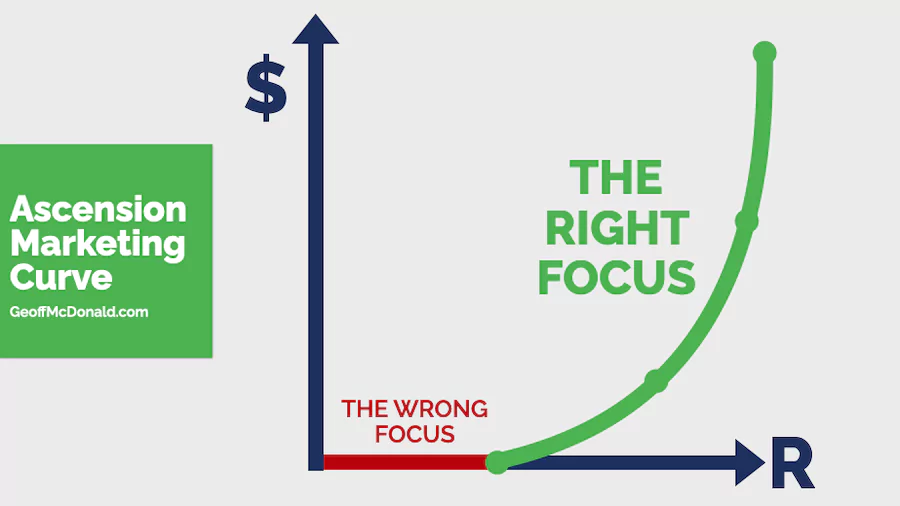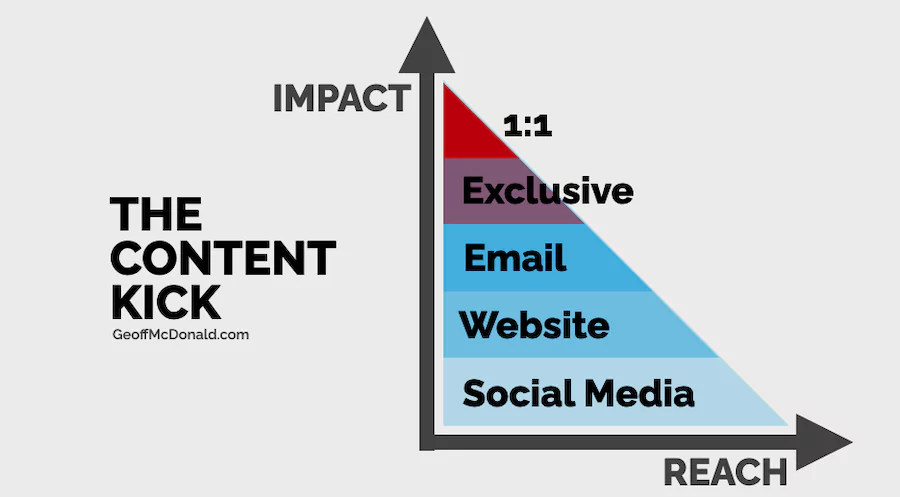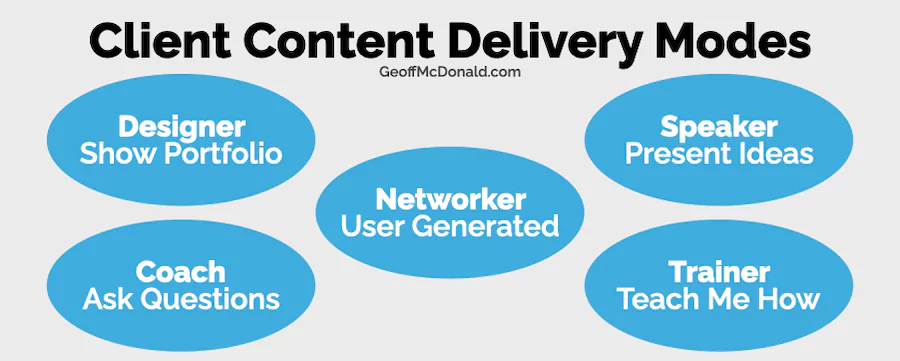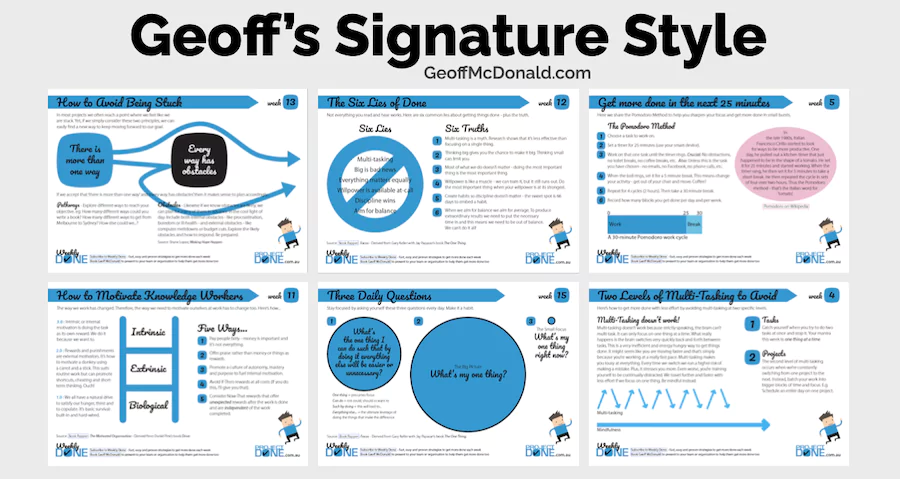Usually when people discuss the best types of Thought Leadership Content to create they look for tactics. They want to know things like: The key to success is to write a 212-word post using three secret hashtags to publish on LinkedIn at precisely 8:37 am on a Tuesday morning and it needs to be liked and commented on by at least 7 people in the first 49 minutes.
The three big questions everyone asks about content creation are:
- What to create
- Where to share it
- How to create it
In this post, we’re going to answer these three big questions – not at a tactics level, but at a strategic level AND through the lens of a thought leader – someone who earns money from their ideas.
Let’s get started: What are the best types of thought leadership content to create? My answers might surprise you because they may not be what you expect.
1 What Content Should a Thought Leader Create?
Let’s start with the all-important question: What content should you create?
To answer this, we need to ask a bigger question: What makes someone a thought leader?
At a simple level, thought leaders lead with ideas.
Why do we have ideas?
Rather than get caught up in trying to define ‘what is an idea?’, let’s instead consider the purpose of ideas.
Why do we have ideas? What purpose do they have?
 Our brains have evolved to have thoughts to help us survive. In caveman days this included not eating the poisonous berry and not being eaten by the sabre-tooth tiger. Today, our survival is more about our social lives – being seen to be a good member of society and being seen to be successful.
Our brains have evolved to have thoughts to help us survive. In caveman days this included not eating the poisonous berry and not being eaten by the sabre-tooth tiger. Today, our survival is more about our social lives – being seen to be a good member of society and being seen to be successful.
It follows that our ideas help us take action. That includes the mundane like, ‘I’m hungry let’s eat’ and all the way to deeper concepts like ‘gravity’ (once we know about how gravity works we can predict what might happen when we drop something and act accordingly.
There are two basic types of actions that our ideas offer:
- Create a Context – The context or frame of reference we choose helps us choose what action to take. For instance, in the context of being at a game of football, yelling at the umpire is often considered part of the spectacle. In contrast, being in school or in church and yelling at the person at the front of the room is usually frowned up.
- Practical Steps – Mostly when we think action, we think about the specific steps we take.
Think like a Doctor
A simple way to think about these two types of action is to consider how a doctor operates (sic). Doctors do two things:
- When a patient walks in they ask them a few questions, look at their bodies for symptoms and then diagnose the problem. This sets the context for what happens next.
- Once the doctor has a diagnosis, they then can prescribe the action you should take – it’s usually a combination of do this and don’t do that. For example, if they suspect a heart attack is about to occur or has occurred then they jump into emergency mode. Alternatively, if they suspect it is simply a virus or a form of flu, they’re more likely to calmly and steadily right a prescription you can take to the pharmacist.
This spotlights the best type of thought leadership content to create: diagnose and prescribe.
- What’s the problem?
- What action should you take?
Your Content Pillars as Diagnosis and Prescription
In the post, Content Pillars – The Insider Strategy to Becoming a Thought Leader, I shared a visual model that describes the steps here in more detail.
It begins by defining the topic (the overarching context), then you define the usual way people think about this situation and then your solution. Effectively, you’re identifying three different contexts at play. Importantly, as a thought leader, you’re saying that your solution is the preferred context or frame of reference to operate from.
Once you’ve identified the context, you can then share your prescription – your rules, principles or strategy for solving the problem. Ideally, you want your clients to buy into your context or frame of reference so they can join you in implementing the actions that follow.
2 Where To Share Your Thought Leadership Content
The second big question to ask about the best type of thought leadership content to create is where are you going to share your content?
And in my opinion, most people get this wrong because they focus on the wrong channel. They want to know should I post on LinkedIn or Facebook, should I do Tik Tok videos or Instagram stories?
I think these are the wrong questions because (again) they are tactical and not strategic. And I think there is a better place to share your content.
Important Lessons from Previous Posts
To share my thoughts here, I need to connect some dots from some previous posts.
- In Create a Service Offering You’ll Fall in Love With, I shared a framework for an Ascension Marketing Curve. The principle behind the graph is that the better the relationship you have with your client the more money they may spend with you.
- Next, in the post, The 5-25 times better Content Marketing Strategy, I shared research published in Harvard Business Review that said it was 5-25 cheaper to service an existing client than attract a new one.
- Effectively, this means most people focus on the wrong part of their audience. Instead of spending most of your time trying to be heard in the noise of Social Media and Content Marketing to attract new clients, you should be focusing on serving your current clients.
- And in the post, on Capital Content – The Daring Content Creation Idea That Doubles Your Results, I suggested the best approach is not to deal with attracting and keeping clients separately. Instead, you want to attract new clients and keep your existing ones by producing one set of content that serves both audiences.
The Content Kick
Now, I want to take this one step further to show you the point of greatest leverage for your thought leadership content creation efforts.
I’ve created a graph called The Content Kick – it shows where you can get the biggest kick out of your content.
On the vertical axis, it shows the impact of your content and on the horizontal axis, it shows the reach or the size of your potential audience. There is a natural trade-off between the two – you can have reach or impact, but not usually both.
And there are five levels to consider. Three of these levels are what people usually think of in terms of content publishing. The other two levels in red are not usually thought about and if you want to avoid content saturation then you might want to consider these.
1 – Social media
On the bottom with the widest reach and lowest impact is social media. Potentially you could reach a lot of people here but there is also a lot of competition.
2 – Website
Above this, we have your website. To be able to find you and then visit your individual website a visitor must have some sort of recommendation either through another person or post, or through Google to find you.
People don’t just open their web browser and amazingly land on your home page. Something must happen for them to arrive at your site.
Also, your website is all about you won’t have to deal with other competing posts (like on social media) which means you’ll have more impact.
3 – Email
One rung above this is your email newsletter. To receive this, the reader needs to have opted-in and given you permission. It’s a smaller audience but a more committed one. Again, the reach shrinks but the impact grows.
4 – Exclusive
Next, we have the two red levels which are the two best places for thought leaders to share their content. This is where it gets interesting. The belief here is that it is where your unique ideas can have the biggest impact.
Above email, we have an exclusive zone. It’s where we give the visitor something that not everyone else can have.
This might refer to a product or service that you sell – that has a form of exclusivity or rarity because not everyone can or will hand over their hard-earned cash to access it.
But I want you to think about this in a different way, I want you to think about this as an experience, not a transaction.
The important question to ask here is: What’s the exclusive experience that only a client can have?
This is where your content is instantly more valuable because it’s less available. For example, an exclusive experience might be to deliver a keynote presentation at a conference. It’s only available to the people who are there at that moment at that conference. Likewise, a live coaching session.
Note: The word ‘experience’ can also apply to products. You might have heard of the phenomenon of people recording and publishing the moment they unbox their new iPhone – this is a product experience.
5 – 1:1 Content Delivery
At the top of the Content Kick triangle is a one-to-one interaction between you and a client.
This is the ultimate point of impact for your content. The reach is as low as it can get – one person, but the impact is as high as it can get because you can personalize your message to the person in front of you.
This is the priority point where thought leaders should be sharing their content. It fits with the idea that you should be creating and sharing your best content with your paying clients. Remember, it’s 5-25 cheaper to keep a client than attract a new one.
Best of all, the content you create for your clients can then be repurposed and shared more freely as Capital Content – to attract the new and keep the current.
One more thing… By creating and sharing your best content with your current clients you are ideally are helping them be more successful. The goal here is to create remarkable content so your clients become raving fans and tell their colleagues about you and your great work.
Bonus Tip: In terms of social media use, it’s more powerful if other people are talking about (ie your clients) than you spruiking yourself. When you promote yourself, it’s advertising. When other people do, it’s a recommendation. Consider providing content to make it easier to recommend you.
The best part of this focus on your clients is that it takes you out of the noisy public space of social media. You’re no longer competing against the flood of content published by others.
3 How to Create Your Thought Leadership Content
The third big question to ask about the best type of thought leadership content to create is: how to create your content?
I find that too many people publish content in a generic way. They simply write down their idea and hit publish because this is the easiest way to get a message out there.
This is a mistake for four reasons.
- For starters, most of us don’t want more stuff to read – we already have enough of that.
- Second, while we all can write, not many can write well. This simply comes down to people not working in their strengths.
- Third, writing often fails to position your expertise because you’re not showcasing yourself in the way that your client wants to see you.
- Worst of all, you don’t stand out. Your content drowns in the flood of posts published every day. And you’re effectively wasting your time and effort.
Five In Mode Content Examples
The alternative to being generic and delivering your content in the same mode as everyone else is to perform ‘In Mode’.
‘In Mode’ means to deliver your content in the same format as you would deliver your content to a client.
For example, if you are a speaker, then speak. Your number one delivery mode for your content should be video so we can see, hear and feel you presenting. In this way, every time we see your content it reinforces ‘speaker’ in our mind.
One of the reasons I produce a video every week is that I want to speak on the TED stage one day. Partly, I’m practising and developing my skills, but I’m also saying ‘I present ideas’. I don’t just write about them – I present them.
Here are four more examples:
- Trainers need to show themselves in teaching mode – teach us something.
- Coaches need to ask great questions as a great coach would do.
- Designers need to show their portfolio of what they have created – and tell us the story of how you created it.
- A networker needs to use the community they have gathered and inspire them to share user-generated content. This can be as a group on Facebook or LinkedIn or it could be part of a crowdsourced solution like Waze where app users show us the best traffic routes to take.
Can you see the connection here? How you present your content should match how you work with your clients. In this way you don’t have to advertise your service, you simply have to present your ideas.
But wait, there’s more. There’s one level beyond that.
Your Signature Style
The one thing better than showing up using your In Mode delivery styles is to do it in your own unique and special way – in your signature style.
My personal example is the style I have created from my days writing book summaries at Book Rapper. It’s a visual one-page snapshot of an idea. The example here is of some of my pages from my books Weekly Done 1 and Weekly Done 2. Have you seen any other books that look like this? Probably not. That’s because it’s my signature style.
To find your signature style ask yourself: What’s your best way?
It starts with knowing yourself and in particular, knowing your strengths. Then it’s simply playtime – express yourself do it your way over time and your signature style will emerge.
And when you work in your strengths, you’ll produce better results and be happier doing it.
Best of all, it’s a natural and obvious way for you and your content to stand out and be noticed.
Summary: The Best Types of Thought Leadership Content to Create
Let’s wrap up what we’ve covered here…
The three big questions everyone asks around Content Creation are:
- What to create
- Where to share
- How to create
When we ask these questions at a strategic level and through the lens of the best types of content for thought leadership we concluded with three core principles:
- Create Action Content that provides a diagnosis and a prescription for action
- Focus on creating content for your clients – deliver it 1:1 and make it exclusive.
- To stand out in a sea of content, create your signature style of content.
More on Thought Leadership Content Creation
Here are some links to related content on Thought Leaders and Content Creation:










